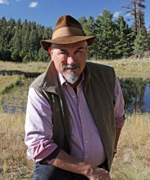A monthly column by Alan Dulaney. For this month only, we’re making Government Goings-on available to the public. Enjoy!

For much of late 2022 and most of 2023 (to date), Arizona and the West have received phenomenal levels of precipitation. This period ranks right in there with the top five in terms of rain and snow, although, for some years to come, nothing will likely challenge 1983’s crown as the ultimate record-holder. Looking at the rain and snow and the floods, many people are asking “Is the drought really over?”
Of course, any hydrologist will know the answer to that common question: “It depends.” What is the snow-water equivalent of all that snow, and what is the time-frame for melting that snowpack likely to be? What are current soil moisture levels, and are they sufficient to allow plentiful runoff? Will runoff match the higher-than-normal precipitation amounts? Most importantly, what locale is the question being asked for?
In Arizona, the Salt-Verde River system is full. Salt River Project (SRP) is releasing water, and there is talk of planning for possible construction at Bartlett Dam to capture more runoff in the future. The Verde River has the least amount of storage on the SRP system, and raising the height of Bartlett Dam would put more water into the system. This would greatly benefit the ten cities in Maricopa County that receive SRP water. While the system was originally built to supply irrigation water for Salt River Valley farmers, most of the water deliveries were long ago “cut over” to cities incorporating lands into their boundaries that in modern times produced more subdivisions than cotton or citrus, such that 90% of SRP water deliveries go to municipal utilities. Some cities will benefit more from the full SRP reservoirs; Tempe, Chandler, the older parts of Mesa and Phoenix, for example, since much of their land was pledged by farmers in the early part of the 20th Century as collateral for construction of Roosevelt Dam. Glendale, Peoria, Avondale, and Scottsdale have smaller allocations, as fewer of their former farm lands were originally irrigated with SRP water. Full reservoirs on the system mean those cities will have less of a problem meeting growing municipal demand.
But the real locale in question is the Colorado River system. Everyone in the country has seen photos of the “bathtub rings” around Lake Mead, marking the drop in water levels. Everyone has seen the mudflats and detritus emerging from a shrinking Lake Powell. So what does all this mean for the two giant reservoirs and the Lower Basin states? Is the megadrought over?
Well, no, not really. Megadroughts last decades, and this one only began in 2000; it has some time to run. Yet even within a long drought, every few years the occasional period of average or above-average precipitation can — and usually does — occur. This is one of those times. It doesn’t mean the drought is over, and the lakes will quickly refill. It would take several years of similar above-normal precipitation and runoff to make a dent in that massive shortage of water. And that, of course, is not likely.
However, the amount of winter precipitation has been enough to give some optimism to future projections of water level elevations in Lake Powell, the reservoir that is key to the entire system. Just last year, water level elevations were dropping within inches of 3520 ft, well below the 3525 ft level that the Bureau of Reclamation sees as the absolute minimum buffer elevation needed to protect Glen Canyon Dam. But recently, Reclamation has been running modeling studies that suggest Lake Powell water levels could rise to 3546 ft, and perhaps even 3582 ft, based on probable inflows between the January highs and March lows. Obviously, this would be good news, as the releases could range from 7.83 to 9.50 maf in 2023. Last year, inflows were so bad that Reclamation cut releases from Lake Powell to 7.0 maf after the April modeling run, and then said they needed another 2–4 maf of demand cutbacks beyond the 7.0 maf. So bigger releases from Lake Powell put more water in Lake Mead.
You can also view the new Colorado River dashboard that CAP has published online. The projections differ slightly from those on the Reclamation website, but they are within a couple of feet of each other. You can see just how bad a year 2022 was for the Colorado River system.
Lake Mead enjoys a water level elevation in late March of 1046 ft. That is still within a Tier 2a declared shortage condition. If Lake Powell releases only 7.0 maf in 2023, then Lake Mead water levels may drop just below 1025 ft, the trigger elevation for a Tier 3 shortage. But if Lake Powell releases rise above 7.48 maf, then the Lower Basin will stay within the Tier 2a shortage. Not pleasant, but it does provide a little breathing room to complete the negotiations on future shortage guidelines that must be done by year’s end 2025. Those negotiations are vital to the system, in that the demand for water in the Lower Basin must match the available supply.
If this megadrought — which is not over — has taught us anything, it should be that we cannot count on the endless bounty of the Colorado System.